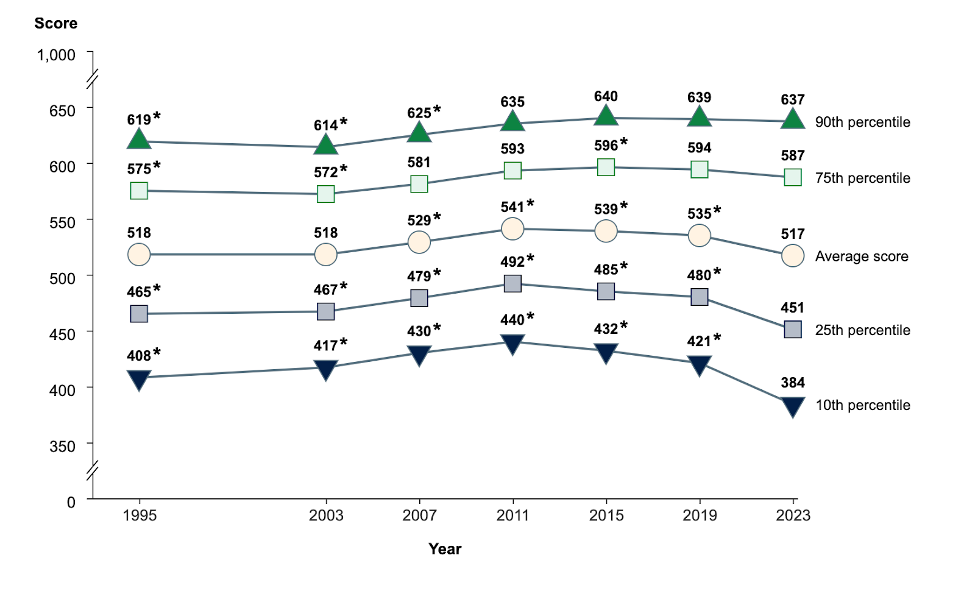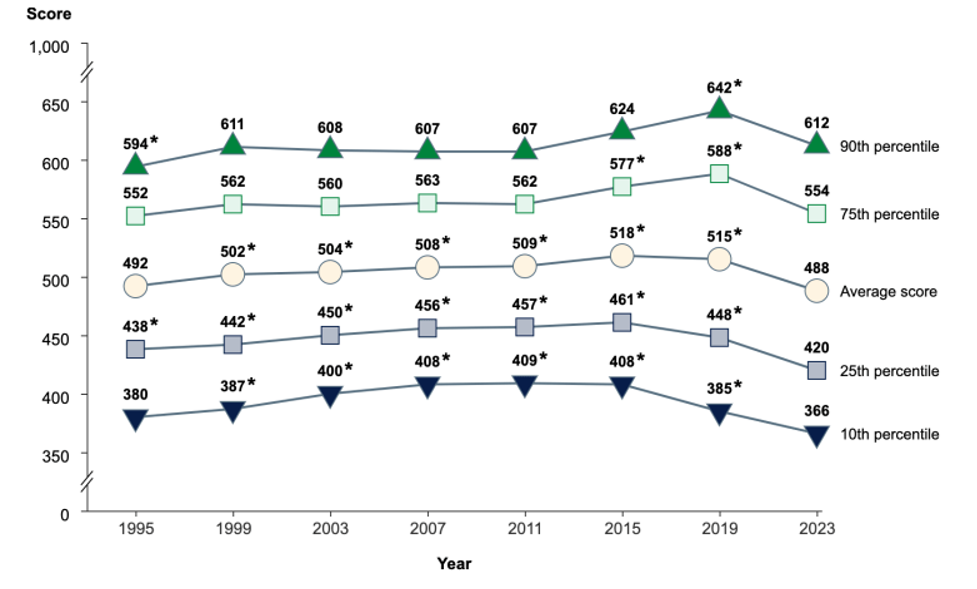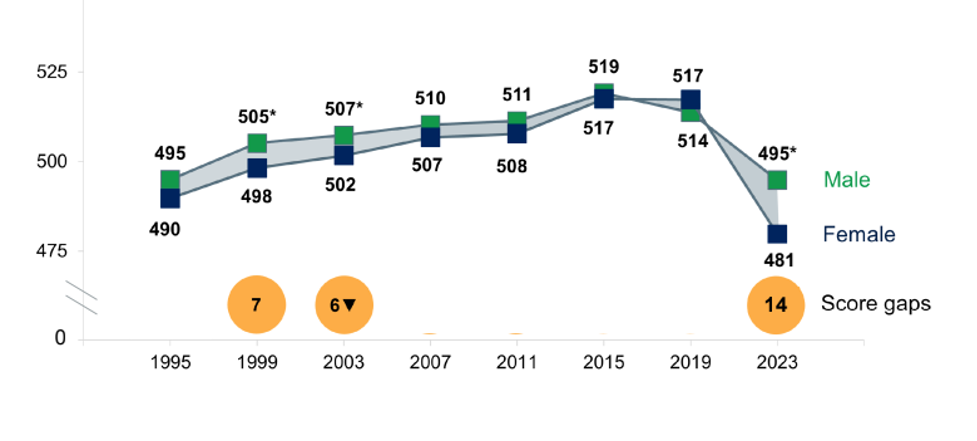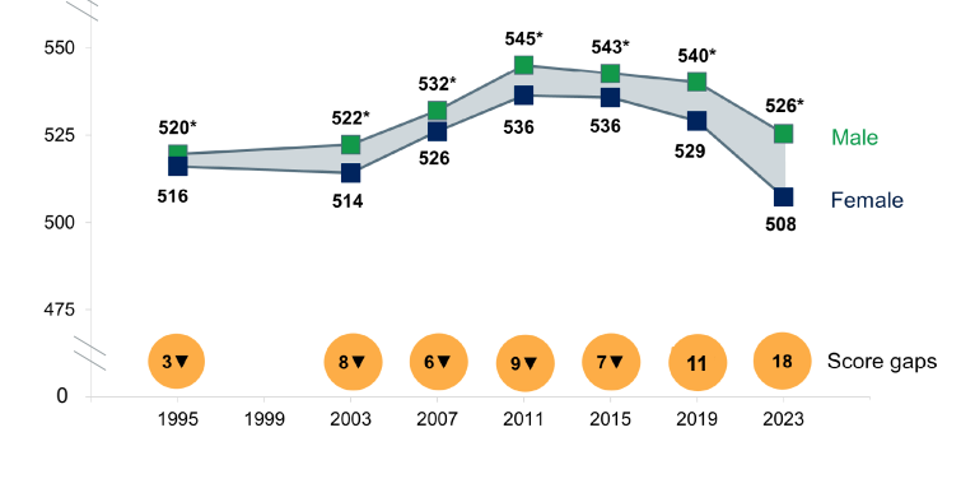“There is a decline in the middle grades,” said Peggy Carr, commissioner of the National Center for Education Statistics, which is responsible for administering TIMSS there. Carr said this group of students is being pulled down — a trend she’s seeing across different tests and subjects since the pandemic.
U.S. TIMSS 4th graders, 1995-2023, by student percentiles

Another way to understand the shrinking middle is to see how few American children meet basic math standards. The test found that 13 percent of fourth graders could not add and subtract numbers with up to three digits, multiply and divide single-digit numbers and solve simple word problems. In 2019, the last time the test was administered, only 7% of fourth graders failed to master these basics. In 2023, 32% of American fourth graders failed to reach the second of four levels, known as “intermediate,” meaning they could not multiply three-digit numbers, add decimals, or measure distances. in a straight line. In other words, a third of fourth graders struggle with grade-level math.
England, Germany and Portugal all had more pupils reaching and exceeding these two lower levels. (Click here to see how many fourth graders in each country achieved all four levels: low, intermediate, high and advanced.)
“The shrinking middle is something that sets the United States apart,” Carr said. Although the middle decline was more pronounced in fourth-grade math, Carr said he noticed a similar decline in the skills of average U.S. adults, ages 16 to 65, in another 2023 international assessment, also released this month -this.
The growing bifurcation of math skills between a small group at the top and a growing group at the bottom, with a dip in the middle, reflects the distribution of income among American households. “It looks like society,” said Goldhaber, a labor economist who worries that academic losses triggered by the pandemic will make it harder for many young Americans to earn a good living. “They predict greater inequality in the future,” he said.
Math skills among even the highest-scoring eighth graders have deteriorated

The math history of eighth graders is different from that of fourth graders. Achievement gaps between the lowest and highest scoring eighth graders did not widen. But the math scores of the highest-performing students fell dramatically, 50 percent more than those of the lowest-performing students.
It is not clear what is behind this decline.
These eighth graders were in fifth grade when the pandemic hit in spring 2020. Despite tutoring and extra help at home, many students in the top 90th percentile do not appear to master middle school math skills as well as former high-achieving eighth graders. .
These results show the importance of teaching mathematics in school as children grow up, and how difficult it is, even for wealthy families, to make up for missed class time.
The gender gap reappears
Historically, American boys perform better than girls in math. This gender gap disappeared in 2015 among eighth graders. But as scores fell, the gender gap re-emerged in 2023. The gender gap never disappeared in fourth-grade math, but in 2023, boys dominated girls with the most large margin never seen before.
Boys still ahead of girls in eighth-grade math

A historic gap between boys and girls in fourth grade mathematics

“Crazy” models around the world
William Schmidt, a professor at Michigan State University, has studied international assessments for decades and analyzes math curricula around the world. He called the TIMSS 2023 results “the craziest” he had ever seen and said it was difficult to make sense of the mixed results. Some high-performing countries have fallen significantly while remaining at the top. Meanwhile, Turkish students, which had never been a high-achieving country, suddenly rose to the next level. It will take time to understand what this means. (Here are the international rankings for fourth and eighth grade math.)
Students in Sweden, who kept their schools open during the pandemic, showed significantly higher math scores between 2019 and 2023. Their fourth graders achieved a record. Yet analysts were unable to determine whether shorter school closures were systematically linked to greater gains in math. Sometimes scores moved in opposite directions within the same country. For example, English fourth graders have slipped while the nation’s eighth graders have improved. Covid closures were similar for both groups of students. Schmidt says it will take researchers more time to gather this data and analyze it. (Here are the historical math scores, from 1995 to 2023, for each nation among fourth and eighth graders.)
Calculation of the Covid effect
Another conundrum is how much of the decline in U.S. math scores should be attributed to Covid and how much should be attributed to other problems in U.S. math education. Notably, the math scores of American fourth graders have been declining since 2011. Eighth graders have had lower math scores since 2015. They could well have continued to decline between 2019 and 2023 if the pandemic had not never happened.
Reasons to hope
It’s discouraging that the United States consistently ranks far behind the top 10 countries in math. (In the 2023 TIMSS, U.S. eighth graders ranked 22nd out of 44 countries and subnational regions.)
Yet there are 360,000 American eighth graders in the top 10 percent who score at the highest of the four levels. Average students in Singapore, the highest-performing city, do just as well, but there are only 33,000 eighth-graders in total in the city-state, according to Tom Loveless, an independent researcher who studies international assessments . Some of these advanced American students could eventually develop the skills needed to cure cancer or find a cost-effective alternative to fossil fuels. Some will start businesses and propel the American economy.
“One of the lessons from this is that the sheer size of the United States makes up for a lot,” Loveless said. “We produce 360,000 kids every year who enter high school and they know an awful lot of math.”
Another potential positive is that this TIMSS test was administered in spring 2023, a year and a half ago. Since then, several 2024 state tests show students bouncing back, even if only to a small extent. Spring 2024 scores are up in New York, Florida and California. “Forty years from now, we could see these TIMSS scores as the lowest, representing the full impact of the pandemic,” Loveless said. “We might have some progress from now on.”
If there is a rebound, we should be able to detect it on the 2024 National Assessment of Educational Progress (NAEP) which was administered earlier this year. These scores should be published in early 2025. I will keep an eye on them.
Contact the editor Jill Barshay at 212-678-3595 or barshay@hechingerreport.org.



